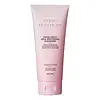What's inside
What's inside
 Key Ingredients
Key Ingredients

No key ingredients
 Benefits
Benefits

 Concerns
Concerns

 Ingredients Side-by-side
Ingredients Side-by-side

Water
Skin ConditioningCocamidopropyl Betaine
CleansingPotassium Cocoyl Glycinate
Acrylates Copolymer
Sodium Chloride
MaskingGlycol Distearate
EmollientSodium Hydroxide
BufferingPhenoxyethanol
PreservativeCitric Acid
BufferingChlorphenesin
AntimicrobialDisodium EDTA
Disodium Cocoyl Glutamate
CleansingSodium Cocoyl Glutamate
CleansingSodium Lauroyl Glutamate
Sodium Methyl Cocoyl Taurate
CleansingNiacinamide
SmoothingTocopheryl Acetate
AntioxidantHamamelis Virginiana Extract
AntiseborrhoeicHydrolyzed Milk Protein
Skin ConditioningHelianthus Annuus Seed Oil
EmollientPropolis Extract
Skin ConditioningGlycerin
HumectantCaprylyl 2-Glyceryl Ascorbate
AntioxidantHoney Extract
HumectantRoyal Jelly Extract
Skin ConditioningPropylene Glycol
HumectantDiazolidinyl Urea
PreservativePotassium Sorbate
PreservativeSodium Benzoate
MaskingCI 77891
Cosmetic ColorantWater, Cocamidopropyl Betaine, Potassium Cocoyl Glycinate, Acrylates Copolymer, Sodium Chloride, Glycol Distearate, Sodium Hydroxide, Phenoxyethanol, Citric Acid, Chlorphenesin, Disodium EDTA, Disodium Cocoyl Glutamate, Sodium Cocoyl Glutamate, Sodium Lauroyl Glutamate, Sodium Methyl Cocoyl Taurate, Niacinamide, Tocopheryl Acetate, Hamamelis Virginiana Extract, Hydrolyzed Milk Protein, Helianthus Annuus Seed Oil, Propolis Extract, Glycerin, Caprylyl 2-Glyceryl Ascorbate, Honey Extract, Royal Jelly Extract, Propylene Glycol, Diazolidinyl Urea, Potassium Sorbate, Sodium Benzoate, CI 77891
Water
Skin ConditioningC15-19 Alkane
SolventPEG-6 Caprylic/Capric Glycerides
EmulsifyingPEG-7 Glyceryl Cocoate
EmulsifyingSodium PEG-7 Olive Oil Carboxylate
EmulsifyingButylene Glycol
HumectantHydroxyethyl Acrylate/Sodium Acryloyldimethyl Taurate Copolymer
Emulsion StabilisingPEG-80 Sorbitan Laurate
Polyacrylate Crosspolymer-6
Emulsion StabilisingSaccharide Isomerate
HumectantSodium Benzoate
MaskingNelumbo Nucifera Stamen Extract
Skin ProtectingTrisodium Ethylenediamine Disuccinate
Glycerin
HumectantPotassium Sorbate
PreservativeLactic Acid
BufferingGlyceryl Acrylate/Acrylic Acid Copolymer
HumectantPropylene Glycol
HumectantPvm/Ma Copolymer
Emulsion StabilisingWater, C15-19 Alkane, PEG-6 Caprylic/Capric Glycerides, PEG-7 Glyceryl Cocoate, Sodium PEG-7 Olive Oil Carboxylate, Butylene Glycol, Hydroxyethyl Acrylate/Sodium Acryloyldimethyl Taurate Copolymer, PEG-80 Sorbitan Laurate, Polyacrylate Crosspolymer-6, Saccharide Isomerate, Sodium Benzoate, Nelumbo Nucifera Stamen Extract, Trisodium Ethylenediamine Disuccinate, Glycerin, Potassium Sorbate, Lactic Acid, Glyceryl Acrylate/Acrylic Acid Copolymer, Propylene Glycol, Pvm/Ma Copolymer
Ingredients Explained
These ingredients are found in both products.
Ingredients higher up in an ingredient list are typically present in a larger amount.
Glycerin is already naturally found in your skin. It helps moisturize and protect your skin.
A study from 2016 found glycerin to be more effective as a humectant than AHAs and hyaluronic acid.
As a humectant, it helps the skin stay hydrated by pulling moisture to your skin. The low molecular weight of glycerin allows it to pull moisture into the deeper layers of your skin.
Hydrated skin improves your skin barrier; Your skin barrier helps protect against irritants and bacteria.
Glycerin has also been found to have antimicrobial and antiviral properties. Due to these properties, glycerin is often used in wound and burn treatments.
In cosmetics, glycerin is usually derived from plants such as soybean or palm. However, it can also be sourced from animals, such as tallow or animal fat.
This ingredient is organic, colorless, odorless, and non-toxic.
Glycerin is the name for this ingredient in American English. British English uses Glycerol/Glycerine.
Learn more about GlycerinPotassium Sorbate is a preservative used to prevent yeast and mold in products. It is commonly found in both cosmetic and food products.
This ingredient comes from potassium salt derived from sorbic acid. Sorbic acid is a natural antibiotic and effective against fungus.
Both potassium sorbate and sorbic acid can be found in baked goods, cheeses, dried meats, dried fruit, ice cream, pickles, wine, yogurt, and more.
You'll often find this ingredient used with other preservatives.
Learn more about Potassium SorbatePropylene Glycol is an odorless, colorless liquid. As a humectant, it helps skin retain moisture. It also aids in delivering active ingredients.
Another role of this ingredient is preventing a product from melting or freezing. Propylene glycol also adds antimicrobrial properties to a product, elongating product lifespan.
This ingredient is considered an organic alcohol and commonly added into both cosmetics and foods.
Those with sensitive skin or conditions may develop a rash when using this ingredient.
Learn more about Propylene GlycolSodium Benzoate is a preservative. It's used in both cosmetic and food products to inhibit the growth of mold and bacteria. It is typically produced synthetically.
Both the US FDA and EU Health Committee have approved the use of sodium benzoate. In the US, levels of 0.1% (of the total product) are allowed.
Sodium benzoate works as a preservative by inhibiting the growth of bacteria inside of cells. It prevents the cell from fermenting a type of sugar using an enzyme called phosphofructokinase.
It is the salt of benzoic acid. Foods containing sodium benzoate include soda, salad dressings, condiments, fruit juices, wines, and snack foods.
Studies for using ascorbic acid and sodium benzoate in cosmetics are lacking, especially in skincare routines with multiple steps.
We always recommend speaking with a professional, such as a dermatologist, if you have any concerns.
Learn more about Sodium BenzoateWater. It's the most common cosmetic ingredient of all. You'll usually see it at the top of ingredient lists, meaning that it makes up the largest part of the product.
So why is it so popular? Water most often acts as a solvent - this means that it helps dissolve other ingredients into the formulation.
You'll also recognize water as that liquid we all need to stay alive. If you see this, drink a glass of water. Stay hydrated!
Learn more about Water